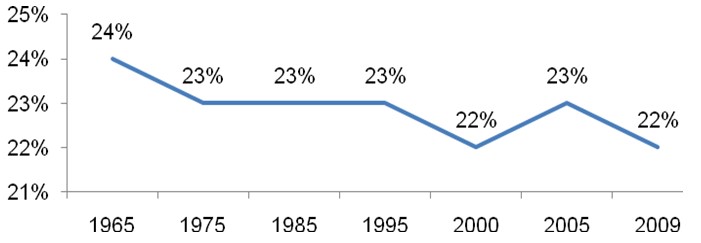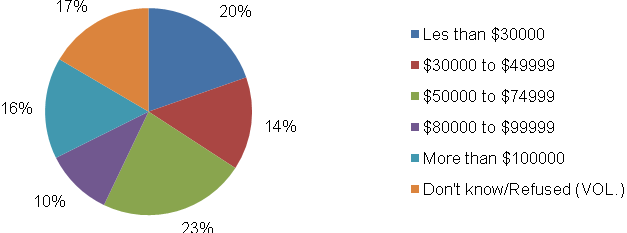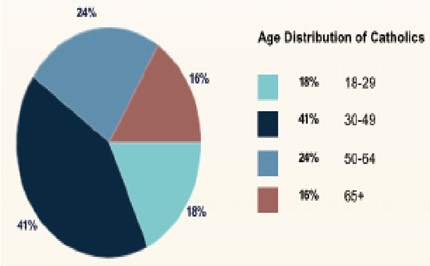Introduction
The affiliation of Americans to religion is an anomaly, which social scientists have constantly tried to evaluate. Even though it is a secular country, religious participation and affiliation are above average in the US compared to other western industrialized nations (Hadaway, Marler and Chaves 741). Further, the rate of religious activity also shows a lot of stability. Overall, the population share of Protestant affiliates has been remaining stable since the 1940s; however, the Catholic affiliates have declined since the 1960s and 1970s. It was noted in a study by Hout and Greeley conducted in 1987 (cited in Hadaway, Marler and Chaves 741) who noted that from 1930 to 1940 there had been a steady decline in the Catholic self-reports. Approximately 40 percent of the US population visited the church on weekly basis. Gallup’s study conducted in 1991 showed that 42 percent of the adult Americans visited churches of whom 45 percent were Protestants and 51 percent were Catholics (Princeton Religion Research Center 4). Sociologists have often bolstered the argument for American secularism based on high participation rates. However, the trend is changing.
Diversity in the American population is said to be reshaping the demographic profile of the religious population of the country (Warner 20). Such has been observed by the Vatican, reported in New York Times, as there have been drastic demographic changes in the Catholic Christian world all over the developed countries, especially the United States (Bruni). Therefore, a shift in the demographic profile of the US population has been observed by many and is a case of serious discussion in Washington. This is important in view of the increasing trend of secularism in the country, which can be observed in the country due to a recent decline in the Church attendance and less affiliation with the Church. This report studies the demographic change in the US and how and in which direction it has moved. The paper also tries to ascertain why there has been a shift in the demographic character of the Catholics in the US.
Demographic Character of Catholics in US
Population
According to a study conducted by the Baylor Religion Survey (Baylor Religion Survey) in 2006 there was 21.2 percent of the population who were Catholics. Majority of the population was protestant, which comprised of 55.7 percent of the sample. A historical study of the Catholic population in the US shows that there has been a decline in the population ratio of Catholics in the US population. As figure 1 demonstrates, the percentage of Catholics in 1965 was 24 percent in the US, which declined in the 1970s to 23 percent. It remained stable in the decades of 1980s and 1990s and then again fell in 2000 to 22 percent. With a minor rise in the Catholic population in 2005 to 23 percent was temporary as it continued declining through 2009 until it settled at 22 percent. (CARA)

The data released by PEW Forum on Religion and Public Life in 2008, which was a result of their survey, “U.S. Religious Landscape Survey”, partially showed the declining population share of Catholics in the US. The PEW study was conducted among adult Catholics in the and US self-reported the findings. The study suggested:
“Catholicism has experienced the greatest net losses as a result of affiliation changes. While nearly one-in-three Americans (31%) were raised in the Catholic faith, today fewer than one in four (24%) describe themselves as Catholic. These losses would have been even more pronounced being it not for the offsetting impact of immigration … the Catholic share of the U.S. adult population has held fairly steady in recent decades, at around 25%. What this apparent stability obscures, however, is the large number of people who have left the Catholic Church. Approximately one-third of the survey respondents who say they were raised Catholic no longer describe themselves as Catholic.” (Cited in CARA, 1)
Therefore, Catholic affiliates had constantly declined in the total population. However, the study also suggests that it is the immigration population, which has helped to keep the ratio higher than it would be. The report suggested that a “disproportionately high number of Catholics among immigrants to the U.S.” (Cited in CARA, 1) Further, there is almost 10 percent of the Americans who report having been raised as Catholics but do not visit the church indicating a shift in their religious preference. The constant decline in the share of Catholics shows a declining trend in the population towards non-affiliation with Catholicism. This trend is not exclusive for Catholic Church as there has been a decline in the share of Protestants too in the US pupation (PEW Forum). Clearly, a greater influx of immigrant Catholics in the US has raised the ethnic diversity in the US Catholic population. This will be reviewed in the following sections.
Gender
The study also showed a gender-wise division of the Catholic population of America. The study showed that there was 23.8 percent were male and 18.9 percent were female (Baylor Religion Survey). The study shows that there were more self-reported male Catholics in the US than females. Further analyzing the data from the dataset from the religious landscape survey conducted by PEW in 2008, we see that there is a higher number of female respondents amounting to 56.1 percent of the respondents and 43.6 percent of the respondents were found to be Catholics of 8061 Catholics surveyed (PEW). The survey showed a marked increase in the number of adult Catholic adults in the US in 2008 than in 2006.
Gender is an important aspect to study as women are more likely to be affiliated to Church than men (D’antonio, Davidson and Hoge 129). Further women’s participation in Church life has increased considerably and even though traditionally they had been marginalized by Catholic tradition by prohibitions and ordinations. However, it is argued that Catholic men and women are similar in their Catholic identity (D’antonio, Davidson and Hoge). Nevertheless, the study by D’antonio, Davidson and Hoge asserts that among Catholics the commitment to the religion is higher among women (130).
Income
The income statistics shows that most of the Catholics in the US are in 2008 shows that there has been an income distribution among 20 percent of the Catholics has an income of less than $30,000. The incomes of Catholic Americans with income more than $30000 and less than $50000 were 14 percent. The majority of the adult Catholics in America have an income of $50000 to $80000, which forms 23 percent of the whole sample group. Catholics with more than $100000 income forms 16 percent of the total adult Catholic sample (PEW). The data does not suggest any relationship between inclination towards Catholicism and their income levels. However, generally, it can be deduced that people with a higher level of income have a higher affiliation towards Catholicism in the US.

Therefore, the study shows that more US Catholics form the cluster wherein the individual income is higher. The clusters wherein more US Catholics have a salary higher than $80000 show that there are more female members than males. This indicates that among Catholics, females have higher income compared to men. This shows that more females at the higher income level have a greater religious affiliation than women in the lower income levels. However, the trend for men is just converse as more men are seen to be affiliated to Catholicism at lower income levels.

Age
A segregation according to to age shows that more people 18 percent of the Catholics are found to be within the age group of 18-29. At the age group of 30 to 49 years, the largest chunks of US Catholics have been found by the study. The age group of 50 to 54 years have 24 percent of the respondents and 15 percent comprise of more than 65 percent of the respondents. Therefore, the data suggest that middle aged Americans i.e. 30 to 49 years of age are mostly affiliated to the religion. Therefore in the middle aged group of 30 years to less than 55 years there most of the Catholics can be identified which comprises of 65 percent of the total respondents.

Race/Ethnicity
Research conducted by PEW indicates that the ethnic background of US Catholics in 2008. The study shows that the Catholics self-reported that 83.7 percent of the Catholics were US-born. 14.9 percent were born in another country. In this people born in other countries, 0.8 percent was born in Puerto Rico, 0.1 percent in other US territories like Guam, Samoa, Virgin Islands, etc (PEW). The Baylor Religion Survey report suggested that in 2006 there were 22.8 percent white Catholics in the US and 5 percent were of African American descent (11). The PEW report of Catholics in 2008 suggests that the percentage of whites in Catholics was 65 percent, 2 percent were African Americans, 2 percent were Asians, and 2 percent were others. One of the second largest groups of Catholics in the US after the Whites was Hispanics who comprised 29 percent of the total Catholic population in the US (PEW Forum). The PEW study suggests that there has been an increasing affiliation of Hispanics towards Catholicism in the US. This may be owing to the large amount f Hispanic immigrants in the country. However, this related affiliation of Latinos was declining according to o PEW. They identified that the self-reported affiliation towards Catholicism among Hispanics was declining since 2008 when it was 58 percent, which was as high as 68 percent in 2006 (PEW Forum).
According to the 2006 U.S. Census Bureau’s American Community Survey (ACS), there were approximately 221.6 million self-identified Hispanics in the US (CARA). Therefore, we consider that the PEW estimates to be correct and assume that 10 percent of these Hispanics are adults then there were presumably 18.1 million adult Catholic Hispanics in the US. Therefore, the study indicates that Hispanics form the largest chunk of Catholic affiliates in the US, however; the affiliation among Hispanics has been declining.
Another trend that is observable in the study is the percentage of self affiliates adult Catholics who have suggested that their parents (father or mother or both) were born outside the US. This indicates that 69.3 percent of the respondents state that their parents were not born in the US. This indicates that they are the second generation of immigrants. Further detailed analysis shows that 48 percent of the Catholics stated that they were citizens of the United States, while 49.5 suggested that they were not. This indicates that a large number of Catholics in the US were actually non-US citizens. Historically it has been observed that since the 1970s the percentage of Catholics who were non-US citizens was higher than the population of Catholics who were the citizens of the US (CARA 10).
Education
According to the PEW study of 2008, we see that Catholics were mostly High School graduates comprising 36 percent of the total population. 21 percent of the population was seen to be college graduates who did not provide a 4-year graduate and 16 percent were college graduates with 4-year degrees. 10 percent of the population were postgraduates or were trained in professional schools. Therefore, the major mass of the Catholic population in the US had a high educational background. This indicated that the Catholic population who showed affiliation with the religion was mostly educated. The study indicates that Catholics have a high ratio of the population who has an inclination towards acquiring education. This would indicate that most Catholics in the US are educated.
Marital Status
The demographic distinction of Catholics in the US based on their marital status shows that 58 percent of the Catholics were married. Only 10 percent were divorced and 7 percent were in a live together relationship. 5 percent of the Catholics were widowed. 17 percent of the Catholics report that they have never been married. Therefore, the study indicates that mostly they are married.
Number of Children
The study indicates that 61 percent of the population who affiliated with Catholicism self-reported that they have no children. 13 percent report that they have one child, 15 percent have two children, 7 percent have three children, and 4 percent have four or more children. Thus in total 49 percent of the Catholic population has children.
Regional Distribution of Catholics
The study suggests that 29 percent of the population is from the Northeast of the country, 24 percent from the Midwest, 24 percent from the South and 23 percent from the West. Therefore, the US Catholic population is almost equally distributed with the largest section being in the Northeast.
Conclusion
The demographic analysis of the Catholics in the US demonstrates that there has been an increasing trend of the Catholic population in the US (D’antonio, Davidson and Hoge 3). There has been an increase in the Catholic population in the country from approximately 18 percent in the 1900-the 30s to 20 percent in the 1940-60s and approximately 23 percent in the 1970s to 2000 (3). Further, our study also shows that there has been a declining ratio of Catholics in the US population. However, our data is restricted from the 1960s to 2009. Another trend that the demographic study has observed is an increase in the diversified Catholic population in the US. This finding has been supported by D’antonio, Davidson and Hoge who have found that the Catholic population in the US has become increasingly diversified in the decades of 1970 to 2000. This study shows that after White Americans, the second-largest ethnic group who comprise the Catholic religious segment are the Hispanics. The demographics study also shows that there have been more female Catholic adults than males and the income of Catholic females is higher than that of the men population. Catholics are found to comprise middle to higher-income groups. Further, a large number of Catholics in the US has reported that they are non-US citizens who again are historically relevant as mostly the Catholic population in the US has been residents of US and not citizens of the country. Most of the Catholics are married and most of them have no children. The largest percent of the Catholic population can be found in the Northeastern part of the country. Catholics are mostly educated with the largest number of them having a High school degree or above. Further, the study confirms that US Catholics have been increasing among Hispanics as has been observed by other studies (PEW).
Works Cited
Baylor Religion Survey. American Piety in the 21st Century. Survey. Waco, Texas: Baylor Institue for Studies of Religion, 2006.
Bruni, Frank. “Reshaping a Church With Vitality and Ambition.”2005. New York Times. Web.
CARA. Catholic Church Statistics. 2009. Web.
—. “The Impact of Religious Switching and Secularization on the Estimated Size of the U.S. Adult Catholic Population.” 2008. Center for Applied Research in the Apostolate. Web.
D’antonio, William, et al. American Catholics: Gender, Generation, and Commitment. Walnut Creek, CA: Altamira Press, 2001.
Hadaway, C. Kirk, Penny Long Marler and Mark Chaves. “What the Polls Don’t Show: A Closer Look at the US Church Attendance.” American Sociological Review vol. 58 (1993): 741-752.
PEW Forum. Religious Demographic Profile. 2009. Web.
PEW. The U.S. Religious Landscape Survey. 2008. Web.
Princeton Religion Research Center. “Church Attendance Constant.” Emerging Trends 14(3) (1992): 4.
Warner, R. Stephen. “Coming to America.” Christian Century 121(3)2004 : 20-23.